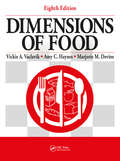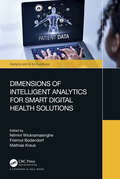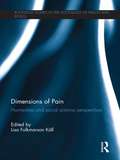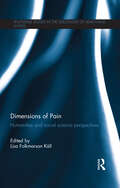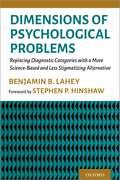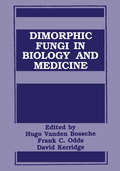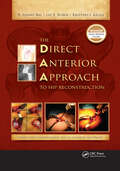- Table View
- List View
Dimensions of Food
by Vickie A. Vaclavik Amy HaynesFollowing its bestselling predecessor, Dimensions of Food, Eighth Edition, provides beneficial classroom and independent, instructive material for students. Instructors will find that this textbook's organization makes it easy to use and very flexible for teaching. A variety of stimulating experiences allow the student to explore and comprehend the numerous dimensions of food. Part I of this lab manual contains an analysis of economic, nutritional, palatability, chemical, sanitary, and food processing dimensions of food. Part II allows students to analyze the structural and functional properties of foods such as starches, fruits and vegetables, eggs, dairy, meat, poultry and fish, fats and oils, sweeteners, and baked goods. Part III features information on microwave cooking, and Part IV concludes with beneficial ideas on meal planning. All chapters in this informative and interactive insight into food science contain learning objectives, exercises, recipes, summary questions, and updated Dietitian's Notes. Contains several helpful Appendices on topics including: Food Guides and Dietary Guidelines, Food Equivalents, Portions, Food Allergens, Food Additives, Legislation, Foodborne Illness, Cooking Terms, Herbs and Spices, and Plant Proteins.
Dimensions of Intelligent Analytics for Smart Digital Health Solutions (Analytics and AI for Healthcare)
by Nilmini Wickramasinghe Freimut Bodendorf Mathias KrausThis title demystifies artificial intelligence (AI) and analytics, upskilling individuals (healthcare professionals, hospital managers, consultants, researchers, students, and the population at large) around analytics and AI as it applies to healthcare. This book shows how the tools, techniques, technologies, and tactics around analytics and AI can be best leveraged and utilised to realise a healthcare value proposition of better quality, better access and high value for everyone every day, everywhere. The book presents a triumvirate approach including technical, business and medical aspects of data and analytics and by so doing takes a responsible approach to this key area. This work serves to introduce the critical issues in AI and analytics for healthcare to students, practitioners, and researchers.
Dimensions of Intelligent Analytics for Smart Digital Health Solutions (Analytics and AI for Healthcare)
This title demystifies artificial intelligence (AI) and analytics, upskilling individuals (healthcare professionals, hospital managers, consultants, researchers, students, and the population at large) around analytics and AI as it applies to healthcare. This book shows how the tools, techniques, technologies, and tactics around analytics and AI can be best leveraged and utilised to realise a healthcare value proposition of better quality, better access and high value for everyone every day, everywhere. The book presents a triumvirate approach including technical, business and medical aspects of data and analytics and by so doing takes a responsible approach to this key area. This work serves to introduce the critical issues in AI and analytics for healthcare to students, practitioners, and researchers.
Dimensions of Pain: Humanities and Social Science Perspectives
by Lisa Folkmarson KällPain research is still dominated by biomedical perspectives and the need to articulate pain in ways other than those offered by evidence based medical models is pressing. Examining closely subjective experiences of pain, this book explores the way in which pain is situated, communicated and formed in a larger cultural and social context. Dimensions of Pain explores the lived experience of pain, and questions of identity and pain, from a range of different disciplinary perspectives within the humanities and social sciences. Discussing the acuity and temporality of pain, its isolating impact, the embodied expression of pain, pain and sexuality, gender and ethnicity, it also includes a cluster of three chapters discusses the phenomenon and experience of labour pains. This volume revitalizes the study of pain, offering productive ways of carefully thinking through its different aspects and exploring the positive and enriching side of world-forming pain as well as its limiting aspects. It will be of interest to academics and students interested in pain from a range of backgrounds, including philosophy, sociology, nursing, midwifery, medicine and gender studies.
Dimensions of Pain: Humanities and Social Science Perspectives (Routledge Studies In The Sociology Of Health And Illness Ser.)
by Lisa Folkmarson KällPain research is still dominated by biomedical perspectives and the need to articulate pain in ways other than those offered by evidence based medical models is pressing. Examining closely subjective experiences of pain, this book explores the way in which pain is situated, communicated and formed in a larger cultural and social context. Dimensions of Pain explores the lived experience of pain, and questions of identity and pain, from a range of different disciplinary perspectives within the humanities and social sciences. Discussing the acuity and temporality of pain, its isolating impact, the embodied expression of pain, pain and sexuality, gender and ethnicity, it also includes a cluster of three chapters discusses the phenomenon and experience of labour pains. This volume revitalizes the study of pain, offering productive ways of carefully thinking through its different aspects and exploring the positive and enriching side of world-forming pain as well as its limiting aspects. It will be of interest to academics and students interested in pain from a range of backgrounds, including philosophy, sociology, nursing, midwifery, medicine and gender studies.
Dimensions of Psychological Problems: Replacing Diagnostic Categories with a More Science-Based and Less Stigmatizing Alternative
by Benjamin B. LaheyA remarkable and extremely important ongoing positive revolution in how we think about psychological problems is rapidly reaching a tipping point. This book provides a manifesto for this revolution. An increasing number of psychologists and psychiatrists are proposing that we either radically change the next edition of the Diagnostic and Statistical Manual of the Mental Disorders and the International Classification of Diseases or leave them behind entirely. The author argues for a view of psychological problems that is far less stigmatizing and better supported by the data but which will require large changes in thinking. First, there is no clear distinction between "normal" and "abnormal" psychological functioning. Psychological problems do not reflect rare and terrifying "illnesses" of the mind, but are problematic ways of thinking, feeling, and behaving that lie on continuous dimensions from minor to severe. Crucially, psychological problems are ordinary aspects of the human experience. They are ordinary in the sense of being commonplace-the great majority of us will experience distressing and disruptive psychological problems at some time during our lives-and are ordinary in arising through the same natural interplay of genetic and environmental influences as any other aspect of behavior. The dimensions of psychological problems are highly correlated and these correlations provide vital clues as that allow us to see a hierarchy of causes of psychological problems for the first time. These range from factors that influence the likelihood of exhibiting some kind of psychological problem, but not which kind, to highly specific causes.
Dimensions of Psychological Problems: Replacing Diagnostic Categories with a More Science-Based and Less Stigmatizing Alternative
by Benjamin B. LaheyA remarkable and extremely important ongoing positive revolution in how we think about psychological problems is rapidly reaching a tipping point. This book provides a manifesto for this revolution. An increasing number of psychologists and psychiatrists are proposing that we either radically change the next edition of the Diagnostic and Statistical Manual of the Mental Disorders and the International Classification of Diseases or leave them behind entirely. The author argues for a view of psychological problems that is far less stigmatizing and better supported by the data but which will require large changes in thinking. First, there is no clear distinction between "normal" and "abnormal" psychological functioning. Psychological problems do not reflect rare and terrifying "illnesses" of the mind, but are problematic ways of thinking, feeling, and behaving that lie on continuous dimensions from minor to severe. Crucially, psychological problems are ordinary aspects of the human experience. They are ordinary in the sense of being commonplace-the great majority of us will experience distressing and disruptive psychological problems at some time during our lives-and are ordinary in arising through the same natural interplay of genetic and environmental influences as any other aspect of behavior. The dimensions of psychological problems are highly correlated and these correlations provide vital clues as that allow us to see a hierarchy of causes of psychological problems for the first time. These range from factors that influence the likelihood of exhibiting some kind of psychological problem, but not which kind, to highly specific causes.
Dimensions on Nursing Teaching and Learning: Supporting Nursing Students in Learning Nursing
by Sheila CunninghamThe book presents five significant areas of learning within professional programmes of preparation most applicable to student nurses and midwives in their pre-registration education but also with relevance to other learners on healthcare related disciplines. This volume has emerged from several sources: the editor’s role as a Director for Learning and Teaching in Adult, Child Nursing and Midwifery and also from an EU funded project looking at quality benchmarks and assuring clinical learning environments (HEALINT). The Francis Report (Francis 2013) and the Shape of Caring Report (Willis 2015) highlighted challenges related to practice learning and mark a renewed focus in its overall significance (Morley et al 2017). In addition to discussions regarding models of support in practice, there is also a clear emphasis on the need for nurses to have the knowledge and skills to undertake more flexible roles and an increasing requirement for nurses to have higher order knowledge and skills at the point of registration, according to the UK Nursing and Midwifery Council (NMC 2017). The book will meet these new educational needs especillay for educators working in Nurse and midwife colleges.The new standards of proficiency for pre-registration nursing were published in 2018, with all higher education institutions (HEIs) approved to deliver the programme from September 2019. This creates a demand for a publication which explores the potential impact of a new education approach and issues with preparation (teaching and learning) for nurses and the breadth and dimensions of teaching and learning. NMC proposed roles of Practice Supervisor, Practice Assessor and Academic Assessor will not have a prescribed preparation programme and universities and practice partners will be seeking guidance and direction in developing local programmes of preparation.
Dimethyl Sulfoxide (DMSO) in Trauma and Disease
by Stanley W. Jacob Jack C. de la TorreFirst isolated as a chemical compound by a Russian chemist in 1866, dimethyl sulfoxide (DMSO) proved to be a near-perfect solvent for decades before its remarkable biological and medical activities were discovered. DMSO is one of the most prodigious agents ever to come out of the world of drug development. Its wide range of biological actions invol
Dimethyl Sulfoxide (DMSO) in Trauma and Disease
by Stanley W. Jacob Jack C. de la TorreFirst isolated as a chemical compound by a Russian chemist in 1866, dimethyl sulfoxide (DMSO) proved to be a near-perfect solvent for decades before its remarkable biological and medical activities were discovered. DMSO is one of the most prodigious agents ever to come out of the world of drug development. Its wide range of biological actions invol
Diminished Ovarian Reserve and Assisted Reproductive Technologies: Current Research and Clinical Management
by Orhan BukulmezThis book brings together the most current research and the latest clinical approaches to the management of diminished ovarian reserve (DOR), one of the largest segments of the IVF patient population, both in the advanced reproductive age group as well as poor responders. Opening with a review of the definition and scope of the problem, as well as the current understanding of the natural history of DOR, subsequent chapters in part I outline dietary, hormonal, traditional supplements and conventional methods used to stimulate ovaries and improve ART outcomes. The main segment of chapters, comprising part II, present minimal and mild stimulation protocols and alternatives, frozen embryo transfer preparation, trigger agents and post-trigger testing, embryo culture and endometrial considerations, and a review of clinical outcomes. Part III discusses the utilization of contemporary technologies in the treatment of DOR, including fresh vs. frozen embryo transfer, cryopreservation and comprehensive chromosomal analysis. Future prospects are presented in part IV, such as the artificial oocyte and ovary development, early-age oocyte freezing, ovarian cortical tissue freezing and activation of the ovarian cortex. Utilizing the latest evidence and authored by an international array of thought leaders, Diminished Ovarian Reserve and Assisted Reproductive Technologies is an excellent resource for reproductive medicine and REI specialists, IVF lab professionals, and students and residents in these areas.
Dimorphic Fungi in Biology and Medicine
by D. Kerridge F. C. Odds Hugo Vanden BosscheFungal dimorphism is a topic that sounds inherently too rarified to attract more than a specialist audience. Yet some 230 individuals representing an eclectic mixture of interests, from basic science to medical practice, gathered in Churchill College, Cambridge in Semptember 1992 for a meeting devoted only to this subject. The symposium was the fourth in a series "Topics in Mycology" to be jointly organized by the Janssen Research Foundation and the International Society for Human and Animal Mycology. The participants enjoyed a rich and varied diet of oral presentations and poster displays in the field of fungal morphogenesis. This book sets down in print the material presented at the dimorphism symposium. We think that the high quality of these papers conveys very well the flavor of what was an excellent meeting. The selection of contributions in this volume covers very wide ground indeed. Chapters devoted to some non-pathogenic fungi are included, because the scientific basis of morphological development belongs to the fields of cellular and molecular biology: it does not recognize the boundary imposed by considerations of virulence of a fungus for a human host. Yet morphogenetic change in those fungi that do cause human disease frequently appears to be a component of the pathological process: many important pathogens change from a hyphal form in the external environment to a round form in infected tissues. This relationship between dimorphism and pathogenicity is the point of contact between pure biology and medicine.
Dioxin Perspectives: A Pilot Study on International Information Exchange on Dioxins and Related Compounds (Nato Challenges of Modern Society #16)
by Erich W. Bretthauer Heinrich W. Kraus Alessandro Di DomenicoErich W. Bretthauer, Chairman of the Exposure and Hazard Assessment Working Group U. s. Environmental Protection Agency Washington, D. C. The efforts of the Exposure and Hazard Assessment Working Group were focused on the exchange of information on a variety of topics including research projects, regulations/statutes, analytical laboratories, and methods of exposure/risk assessment involving CDDs and CDFs. It was evident to the leaders of the Working Group that several of the knowledge voids had to be addressed on a fundamental level before expanded efforts could be made. Several questions needed to be answered: • Who has done research on this topic, and what do the data indicate? • Who is performing research now, and what are their capabilities? • How are other nations addressing this problem, and do they have legislative mandates in place? • Is there a general consensus on the topic? The members of the Working Group believed that these questions could be answered by surveying the major participants in the field of interest. Three principal survey efforts were performed by the Working Group, which collected information on research, regulations/statutes, and analytical laboratories from each of the participating nations. In addition to answering these fundamental questions, these efforts also fulfilled the major objectives of the entire Pilot Study. The collection, analysis, and distribution of information on research projects, regulations/statutes, and analytical laboratories were very useful efforts in helping to fill some of the basic knowledge voids.
Dipeptidyl Aminopeptidases: Basic Science and Clinical Applications
by Uwe Lendeckel Dirk Reinhold Ute BankThis is the first comprehensive volume on Dipeptidyl Aminopeptidases that can be marketed to a wide variety of disciplines, as well as to a variety of clinicians. Leading experts in the field contribute to this state-of-the-art view on these enzymes. This book comes at a time when our understanding of their function is growing ever more rapidly and therapeutic options have become imminent.
Dipeptidyl Aminopeptidases in Health and Disease (Advances in Experimental Medicine and Biology #524)
by Martin Hildebrandt Hans-Ulrich Demuth Torsten Hoffmann Burghard KlappProceedings of the International Conference on Dipeptidyl Aminopeptidases, held September 26-28, 2002, in Berlin, Germany. Dipeptidyl Aminopeptidases exert a potent modulatory role at an interface between immune mechanisms, metabolic responses and neuroendocrine pathways. Experimental models and clinical studies addressing the role of these enzymes and the effect of specific inhibitors pave the way to novel therapeutic concepts in immunology, rheumatology, oncology, reproductive medicine and diabetes. Leading experts in this field have contributed to this book which presents a state-of-the-art view on these enzymes, at a time when our understanding of their function is growing ever more rapidly and therapeutic options become imminent. The sections of the book focus on various topics: - Structure and function of dipeptidyl aminopeptidases, - DPP IV-like proteins, - Immune mechanisms and immune disorders, - Cancer and angiogenesis, - Diabetes and metabolism, - Therapeutic implications.
Diphtherie und Anginen: Band 4 (Bücher der ärztlichen Praxis #4)
by Carl Leiner Felix BaschDieser Buchtitel ist Teil des Digitalisierungsprojekts Springer Book Archives mit Publikationen, die seit den Anfängen des Verlags von 1842 erschienen sind. Der Verlag stellt mit diesem Archiv Quellen für die historische wie auch die disziplingeschichtliche Forschung zur Verfügung, die jeweils im historischen Kontext betrachtet werden müssen. Dieser Titel erschien in der Zeit vor 1945 und wird daher in seiner zeittypischen politisch-ideologischen Ausrichtung vom Verlag nicht beworben.
Diploma in Dental Nursing, Level 3
by Carole HollinsDiploma in Dental Nursing, Level 3 is the new edition of the must-have study companion for trainee dental nurses preparing for the City & Guilds Level 3 Diploma in Dental Nursing (formerly NVQ). The book offers comprehensive support on the units assessed by portfolio - from first aid and health and safety to specific chairside support procedures - as well as the four areas of the course tested by multiple choice questions: infection control, oral health assessment, dental radiography and oral health management. This third edition of an established revision text has been substantially revised and restructured in line with the new qualification and reflects changes in the regulations and legislature affecting dentistry and dental workplaces, all of which have an effect on the daily role and working life of the dental nurse. It will be an invaluable guide for dental nurse trainees, qualified dental nurses and course providers. - Expanded and revised, with extensive coverage of the fifteen Diploma units- In full colour throughout with over 400 illustrations- Companion website with downloadable glossary and MCQs for revision and self-assessment
Diploma in Dental Nursing, Level 3
by Carole HollinsDiploma in Dental Nursing, Level 3 is the new edition of the must-have study companion for trainee dental nurses preparing for the City & Guilds Level 3 Diploma in Dental Nursing (formerly NVQ). The book offers comprehensive support on the units assessed by portfolio - from first aid and health and safety to specific chairside support procedures - as well as the four areas of the course tested by multiple choice questions: infection control, oral health assessment, dental radiography and oral health management. This third edition of an established revision text has been substantially revised and restructured in line with the new qualification and reflects changes in the regulations and legislature affecting dentistry and dental workplaces, all of which have an effect on the daily role and working life of the dental nurse. It will be an invaluable guide for dental nurse trainees, qualified dental nurses and course providers. - Expanded and revised, with extensive coverage of the fifteen Diploma units- In full colour throughout with over 400 illustrations- Companion website with downloadable glossary and MCQs for revision and self-assessment
Diplomacy and Negotiation for Humanitarian NGOs (Humanitarian Solutions in the 21st Century)
by Larry Winter Roeder, Jr. Albert Simard Diplomacy and Funding for Humanitarian Non-Profits is a practical guide to best practices in diplomacy and negotiation for non-profits (NGOs) who work to convince governments and international institutions to effectively protect humans through disaster assistance, sustainable development and the protection of cultures. The volume proposes a holistic approach to humanitarian assistance by integrating non-traditional and traditional humanitarian partners. Users of the book will be prepared to speak to diplomats and government officials in any setting, including war zones. The book mainly focuses on approaching local and national governments, the United Nations system, the international Red Cross movement and other international organizations. The reader will learn the rules of “diplomatic protocol", and much about the rules and procedures of major international bodies, as well as how to leverage media and knowledge management for planning, establishing, and managing a humanitarian initiative. To provide balance and real world relevance, the guide draws on a compilation of the extensive activities of both authors across a range of development, emergency management, knowledge management, and climate issues in government and in the NGO world, as well as interviews with a broad range of scholars and officials from NGOs, diplomatic missions, the media, the United Nations, the Red Cross, governments and corporations.
Direct and Inverse Methods in Radar Polarimetry (Nato Science Series C: #350)
by W. M. Boerner Leonard A. Cram William A. Holm David E. Stein Werner Wiesbeck Wolfgang Keydel Dino Giuli Dag T. Gjessing Édéric A. Molinet Hans BrandThis foreword deals exclusively with the planning, organization, and execution of the Workshop's scientific as well as cultural programs. It is opened with a synopsis on how the global political changes that occurred immediately after the Workshop caused the ~elay in producing the proceedings, followed by a brief exposition on need, timeliness, and importance of this second ARW in the field of electromagnetic imaging, radar remote sensing, and target versus clutter di~rimination; and an outline of the objectives. An informal discussion about some of the organizational details, a retrospective summary of events, and a preview of the third workshop, planned for 1993 September 19-25, is intended to recapture the spirit of this second NATO Advanced Research Workshop (1988 September 18-24), and will reveal how successful it was in compar ison to the first of 1983 September 18-24, how its accomplishments may be appreciated and why a third and last workshop was requested by its participants to take place during 1993 September 19-25.
The Direct Anterior Approach to Hip Reconstruction
by B. Bal Lee Rubin Kristaps KeggiTotal hip arthroplasty has steadily evolved to improve patient outcomes and safety. One innovation has been to incorporate less invasive surgical methods, such as the direct anterior surgical approach. The Direct Anterior Approach to Hip Reconstruction is a comprehensive reference text that addresses contemporary surgeon interest in innovation and less invasive surgery. This resource will help with introductory learning, intermediate technical development, and advanced revision total hip skills using the direct anterior technique. Accordingly, the text is structured into three sections as follows: Basic concepts: Surgical hip anatomy, patient selection, and placement of single, multiple, and extensile incisions for primary total hip arthroplasty Intermediate concepts: Adoption of imaging and navigation technologies, use of traction tables to enhance positioning, and presentation of unique instruments and custom devices that have evolved specifically for the direct anterior approach Advanced concepts: Using the direct anterior approach for bearing and liner exchanges, acetabular revisions, femoral component revisions, and both component revisions. Drs. B. Sonny Bal, Lee E. Rubin, and Kristaps J. Keggi have combined their unique perspectives, along with those of a renowned group of North American and European experts in the anterior hip reconstruction surgery to create this reference. Dr. Keggi was among the first to recognize the benefits of the direct anterior approach in hip reconstruction; this text is based on his 50-plus years of experience as a clinician and pioneer surgeon. The Direct Anterior Approach to Hip Reconstruction provides a stepwise learning process for surgeons interested in mastering total hip arthroplasty using the direct anterior approach, with detailed chapters and video instruction, contributed by a distinguished group of international experts in the field.The chapters focus on using the direct anterior approach to address a variety of hip problems well beyond performing total hip arthroplasty for osteoarthritis. The unique applications of the direct anterior approach within the orthopedic sub-specialties are addressed in chapters covering the fields of pediatrics, sports medicine, trauma, and tumor surgery. Other chapters address subjects like femoroacetabular impingement, hip preservation surgery, and postoperative rehabilitation protocols designed to improve patient outcomes.The final section of the text reviews the evidence-based outcomes related to direct anterior total hip arthroplasty, addressing evolving implant design concepts specific to this approach, and outlining directions for educating the next generation of surgeons who will continue to develop and refine these techniques. Complementing the written text is a website with educational videos to further enhance the learning experience.To date, no other reference has addressed the need for comprehensive education for the orthopedic resident, fellow, or surgeon seeking to learn about the direct anterior approach for hip reconstruction. This resource should be invaluable to orthopedic surgeons worldwide and will contribute to improving patient safety, reducing complications, and better surgical outcomes. Indeed, this landmark publication is truly the world’s first comprehensive text on anterior hip surgery.
The Direct Anterior Approach to Hip Reconstruction
by B. Bal Lee Rubin Kristaps KeggiTotal hip arthroplasty has steadily evolved to improve patient outcomes and safety. One innovation has been to incorporate less invasive surgical methods, such as the direct anterior surgical approach. The Direct Anterior Approach to Hip Reconstruction is a comprehensive reference text that addresses contemporary surgeon interest in innovation and less invasive surgery. This resource will help with introductory learning, intermediate technical development, and advanced revision total hip skills using the direct anterior technique. Accordingly, the text is structured into three sections as follows: Basic concepts: Surgical hip anatomy, patient selection, and placement of single, multiple, and extensile incisions for primary total hip arthroplasty Intermediate concepts: Adoption of imaging and navigation technologies, use of traction tables to enhance positioning, and presentation of unique instruments and custom devices that have evolved specifically for the direct anterior approach Advanced concepts: Using the direct anterior approach for bearing and liner exchanges, acetabular revisions, femoral component revisions, and both component revisions. Drs. B. Sonny Bal, Lee E. Rubin, and Kristaps J. Keggi have combined their unique perspectives, along with those of a renowned group of North American and European experts in the anterior hip reconstruction surgery to create this reference. Dr. Keggi was among the first to recognize the benefits of the direct anterior approach in hip reconstruction; this text is based on his 50-plus years of experience as a clinician and pioneer surgeon. The Direct Anterior Approach to Hip Reconstruction provides a stepwise learning process for surgeons interested in mastering total hip arthroplasty using the direct anterior approach, with detailed chapters and video instruction, contributed by a distinguished group of international experts in the field.The chapters focus on using the direct anterior approach to address a variety of hip problems well beyond performing total hip arthroplasty for osteoarthritis. The unique applications of the direct anterior approach within the orthopedic sub-specialties are addressed in chapters covering the fields of pediatrics, sports medicine, trauma, and tumor surgery. Other chapters address subjects like femoroacetabular impingement, hip preservation surgery, and postoperative rehabilitation protocols designed to improve patient outcomes.The final section of the text reviews the evidence-based outcomes related to direct anterior total hip arthroplasty, addressing evolving implant design concepts specific to this approach, and outlining directions for educating the next generation of surgeons who will continue to develop and refine these techniques. Complementing the written text is a website with educational videos to further enhance the learning experience.To date, no other reference has addressed the need for comprehensive education for the orthopedic resident, fellow, or surgeon seeking to learn about the direct anterior approach for hip reconstruction. This resource should be invaluable to orthopedic surgeons worldwide and will contribute to improving patient safety, reducing complications, and better surgical outcomes. Indeed, this landmark publication is truly the world’s first comprehensive text on anterior hip surgery.
Direct-Fed Microbials and Prebiotics for Animals: Science and Mechanisms of Action
by Todd R. Callaway Steven C. RickeIn this exciting update, readers will learn how feeding direct-fed microbials (including eubiotics, postbiotics, prebiotics, and synbiotics) is becoming increasingly widespread during food animal production. Animal production must improve efficiency of growth, and the use of direct-fed microbial and prebiotic additives to domestic animals has become widely accepted and utilized. The benefits of probiotic-type approaches in cattle, pigs, fish, and poultry, include improved general animal health, reduced foodborne pathogen populations, increased growth rate and feed efficiency, improved milk and egg production, and have been reported world-wide. Successes from probiotic approaches in multiple species have ensured their adoption; however, several fundamental questions remain. Early establishment and retention of an ecological balance in the gastrointestinal tract is an important first step for an external biological additive to be effective in young animals, suggesting that some of the benefits of direct-fed microbials may be due to an early establishment of a “normal” native gut microbial population. Research has indicated that the establishment of a normal population can enhance gut epithelial integrity, preventing inflammation and improving animal health. Thus, it is important that we understand the key processes that occur during the establishment of the gut microbial population that can impact gastrointestinal fermentation and provide protection against pathogens of the animals and of human consumers. Knowing how these processes work and how they impact animal energy and protein expenditures can guide further improvements of available and future commercial products. Exciting research opportunities are discussed in this book, examining different characteristics of DFMs that are fed to animals to meet different production demands in different production scenarios (e.g., beef versus dairy versus swine versus fin fish). The advent of molecular and next-generation sequencing offers methods of developing tailored DFMs, and of early detection of successful DFM establishment in the gut. These techniques will further deepen our insight into understanding the microbial population of the gut and how these populations impact animal health, food safety, and sustainability of animal-derived protein production.
Direct Myocardial Revascularization: History, Methodology, Technology (Developments in Cardiovascular Medicine #211)
by George S. Abela PeterWhittakerThe last five years have witnessed an increasing interest in the subject of transmyocardial laser revascularization (TMR) as illustrated by the number of abstracts presented at the meetings of the American Heart Association and the American College of Cardiology (Figure). The ideas and concepts associated with this particular method of myocardial revascularization have changed dramatically over even this short period of time. The original premise of "de-evolving" mammalian hearts to recreate a reptilian-like myocardial circulation by making multiple channels through the myocardium has been almost (but perhaps not quite) completely dismissed. Now, the most popular notion is that there is an angiogenic response to myocardial channel making. It is this development of new blood vessels that is thought to be responsible for the apparent improvements in symptoms and blood flow. Along the way, the idea that a channel could stay open and allow blood to flow directly from the ventricular chamber has found little support. Rather than directly explore all of these issues and merely duplicate previously published articles, our aim was to take a novel approach: that is, to step back from these arguments and provide perspective from the vantage point of distance. In the case of trans myocardial revascularization, distance comes both in terms of history and in terms of methodology and knowledge from other fields of research. Historically, innovative methods of myocardial revascularization are by no means uncommon. The first two chapters deal with this historical' perspective.
